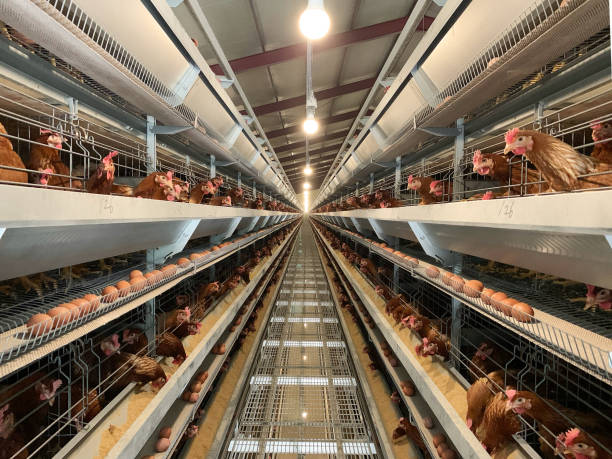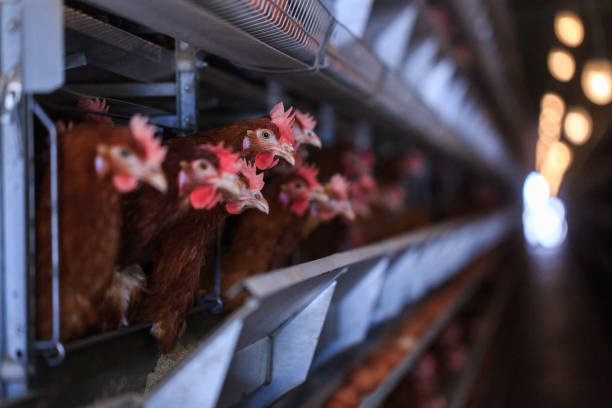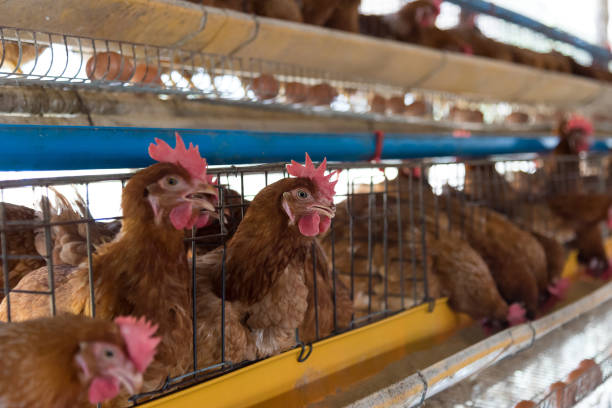
Automatic feeding systems for poultry cages enhance efficiency and productivity
Automatic feeding systems for poultry cages enhance efficiency and productivity
In the fast-paced world of modern poultry farming, staying competitive means optimizing every aspect of production. One of the biggest breakthroughs in the industry in recent years has been the development and widespread adoption of automatic feeding systems for poultry cages. Whether you’re running a small-scale egg farm or managing a large broiler operation, integrating an automated feeding system can significantly boost both efficiency and productivity.
These systems have redefined the way poultry are fed, moving far beyond the traditional manual methods that were time-consuming, labor-intensive, and often inconsistent. Automatic feeding systems ensure that birds receive their nutrition in a timely and uniform manner, which is essential for maintaining optimal growth rates and health. Let’s dive deeper into how this technology is changing the game for poultry producers worldwide.
Understanding automatic feeding systems in poultry farming

At the core of any poultry operation is the goal of keeping birds healthy and productive. This begins with providing them proper nourishment, and that’s where automatic feeding systems come in. These systems are designed to deliver measured amounts of feed directly into poultry cages at predetermined intervals, ensuring that every bird has access to fresh feed when needed.
Automatic feeding systems typically consist of a feed storage silo, conveyors or augers, and feeding mechanisms like chains, pans, or troughs that bring the feed to the bird level. These systems can be completely automated with control panels that let farmers schedule feeding times, adjust feed quantities, and monitor system performance—all with the push of a button.
There are various types of automatic feeding systems available for poultry cages, including:
Chain and flight lines: The most traditional form of automated feeding, this system uses a motor-driven chain that drags feed through the house via a conveyor. It’s commonly used in layer and broiler operations.
Auger systems: These systems use a rotating helical screw blade to move feed down long tubes from the storage silo into the feeding areas. They are especially useful for delivering feed to remote or upper-level cages in multi-tier setups.
Pan feeding systems: Often seen in caged layer operations, pans hang from lines that rotate to distribute feed into designated feeding areas. This system ensures clean feeding spaces and minimizes waste.
Trough feeding systems: Feed is distributed through a channel or trough that runs alongside the cages. These are ideal for barn-style setups or open-concept poultry houses.
Each of these systems brings its own set of advantages, and the right choice depends on the scale of the operation, poultry type (layers vs. broilers), and overall farm layout.
Enhancing efficiency through automation

Perhaps the most immediate benefit of automatic feeding systems is the incredible efficiency they bring to daily farm operations. Feeding is one of the most routine and labor-demanding tasks in poultry farming, especially in larger operations. Manual feeding not only requires a considerable portion of labor hours but also increases the risk of human error—missing a feeding time or providing inconsistent portions can have a negative impact on bird performance.

With automation, however, these feeding operations are completed faster and more consistently. Once programmed, the system takes full responsibility for delivering the right amount of feed at the right time. This consistency is not only critical for bird health but also allows farmers to reallocate valuable labor to other important aspects of farm management, such as health monitoring, maintenance, and quality control.
Moreover, automatic systems reduce feed spillage and waste. Manual feeding often leads to uneven distribution and can result in birds overeating or under-eating due to the clumping of feed or inefficient allocation. Automated feeders are designed to dispense feed precisely, which ensures even consumption and reduces feed wastage—both of which translate to cost savings over time.
Another major efficiency advantage is the ability to remotely manage and monitor the feeding process. Many modern feeding systems are equipped with digital monitoring controls that allow producers to track feed levels, feeding schedules, and overall system performance using smartphones or tablets. This level of control helps prevent disruptions, identify maintenance issues before they escalate, and even integrate with other smart farming technologies for a fully connected production environment.
Improving bird health and productivity
Proper feeding is not just about delivering food—it’s about delivering the right nutrition at the right pace to support healthy development and high productivity. When birds are on an irregular or inconsistent feeding schedule, stress levels can increase, which may lead to weakened immune systems, uneven growth patterns, and lower egg production or meat quality.
Automatic feeding systems help maintain a stable feeding environment. Because feed is provided at regular intervals and evenly distributed throughout the cages, birds don’t have to compete excessively for food, which can dramatically lower stress levels. Reduced competition also leads to a more uniform flock, meaning birds grow at similar rates, which is particularly important in broiler operations aiming for consistent weight gains.
For layer operations, proper feeding cycles are essential for maintaining consistent egg production. Layers need balanced nutrition and a steady feeding schedule to produce eggs regularly and sustainably. An automatic system ensures that essential nutrients are delivered consistently, helping to preserve eggshell quality, internal egg composition, and laying patterns.
In addition, these systems can be programmed to distribute specific diets tailored to the life stage of the birds. Young chicks require a different nutritional profile than mature hens, and many automatic feeders allow for precise switching between starter, grower, and finisher feeds, which further optimizes productivity.
Furthermore, some automatic feeding systems are designed with hygiene and disease prevention in mind. Feeders that keep feed fresh and uncontaminated—by limiting moisture contact or reducing the presence of pests—are key contributors to a healthier flock. Clean feeding zones help prevent the spread of diseases that can be transmitted through spoiled feed or droppings contamination.
Supporting larger-scale operations
As farms grow in size, the importance of scalability becomes evident. Managing a poultry house with 1,000 birds is significantly different from managing one with 50,000 birds. In such cases, automation is not a luxury—it’s a necessity. The ability to manage large numbers of birds efficiently and uniformly would be nearly impossible without the support of automatic feeding systems.
These systems can handle multi-tier cage arrangements and ensure that feed reaches the top tiers just as effectively as the lower layers. This vertical feeding capability is crucial for high-capacity, modern poultry farms that use space-saving multi-level cage designs.
Also, in large-scale setups, automatic feeding systems integrate seamlessly with other technologies like climate control systems, ventilation units, watering systems, and manure removal operations. This synchronization allows for a fully optimized poultry environment where all systems work in harmony to maximize bird welfare and production output.
By reducing reliance on manual processes, producers are also better equipped to maintain a higher standard of biosecurity. Limited human contact with feed and cages lowers the risk of disease introduction, especially when the feeding system is enclosed and controlled automatically.
Environmental and economic benefits
In today’s agricultural landscape, sustainable practices are more important than ever. Automatic feeding systems contribute to environmental conservation by reducing waste, lowering feed overuse, and optimizing resource utilization. Since these systems dispense only the required amount of feed, there is little to no excess that ends up on the floor or exposed to environmental contaminants. Less waste also means fewer organic residues that could lead to bacterial growth or air quality issues within the facility.
From an economic standpoint, the upfront investment in an automatic feeding system may seem high, but the long-term savings are substantial. Reduced labor costs, improved feed conversion rates (FCR), and consistent production levels all contribute to a healthier bottom line. Additionally, farms equipped with automated systems are more attractive for large buyers, co-ops, and distributors who prefer suppliers with stable and traceable production methods.
Moreover, automation opens up access to data that helps farmers make better-increasingly accurate decisions. Feeding patterns, growth curves, and system performance metrics can be collected, analyzed, and used to optimize feed formulas, predict maintenance needs, and improve farm management practices. This data-driven approach is part of the broader movement toward smart agriculture, and it’s already having a measurable impact on profitability.
Choosing the right system for your poultry cages
When selecting an automatic feeding system, it’s important to consider the layout of your poultry house, the species and age of your birds, and the type of cages you use (such as layer cages or broiler cages). Each design and layout has unique feeding requirements that influence the choice of feeding method.
For example, in multi-tier layer operations, pan or trough systems that evenly distribute feed across each level are often the best choice. In larger broiler facilities, chain or auger feeding systems can provide more robust and reliable distribution. It’s also wise to choose a reputable supplier that offers not only high-quality equipment but also ongoing support, maintenance advice, and spare parts availability—key considerations for long-term reliability.
It’s equally important to look into system modularity and scalability. As your business grows, being able to expand your feeding system without needing to overhaul the entire setup can save both time and investment.
Implementation and training
Once you’ve selected the right feeding system for your poultry operation, it’s crucial to ensure proper installation and staff training. Even the most advanced technology is only as effective as the people using it.
Installation should be done with precision to avoid misalignments or blockages in the feed lines. Working with a knowledgeable installer can make this process smooth and minimize downtime. Once the system is operational, your team should be trained on basic maintenance tasks, troubleshooting common issues, setting feeding schedules, and adjusting feed portions according to bird age or flock size.
Training sessions should also cover hygiene practices and cleaning procedures to keep the feeding system contamination-free. Regular checks for wear and tear, blockages, or motor issues can prevent costly breakdowns and ensure the longevity of the system.
Finally, monitoring performance indicators like bird weight, feed consumption, egg output, and mortality rates can serve as benchmarks for evaluating the system’s impact over time. This feedback loop allows producers to make adjustments and continuously refine their feeding strategies.
Conclusion
Automatic feeding systems for poultry cages are more than just a convenience—they’re a strategic investment that can revolutionize the way you farm. From labor savings and increased productivity to improved bird health and sustainability, the benefits are wide-ranging and impactful.
Whether you’re a new producer entering the poultry industry or an established grower ready to modernize your operations, automating your feeding process is a step that delivers measurable returns. As poultry farming becomes more competitive and tech-driven, adopting these advanced systems ensures you’re not only keeping up with the times but leading the pack in efficiency, quality, and performance.
Now is the time to explore the possibilities of automation and discover how feeding your birds has never been smarter.
